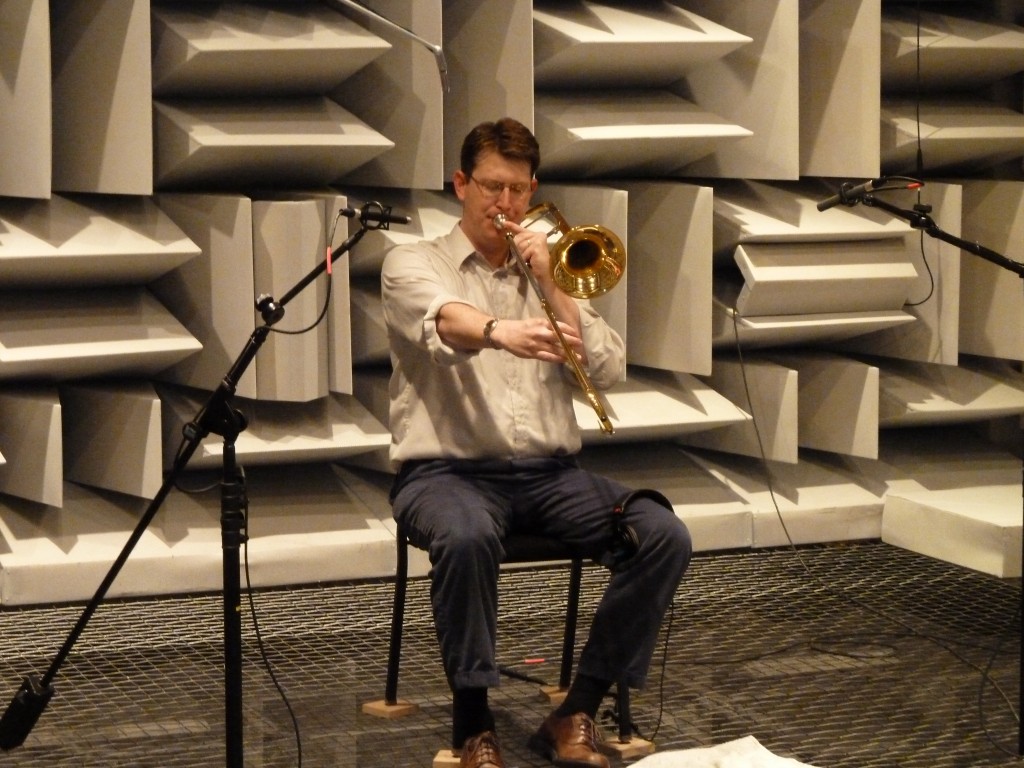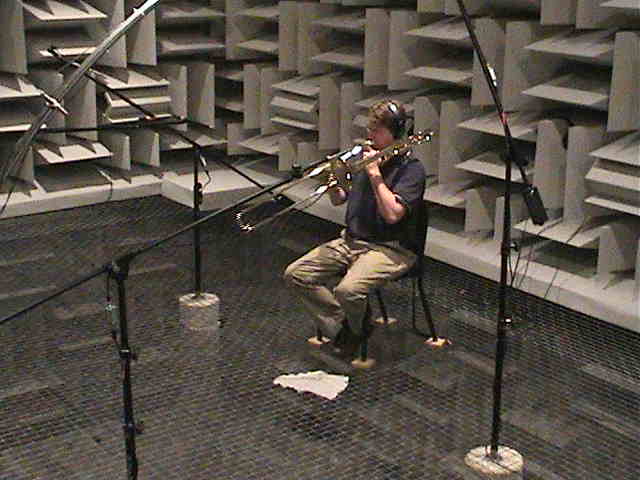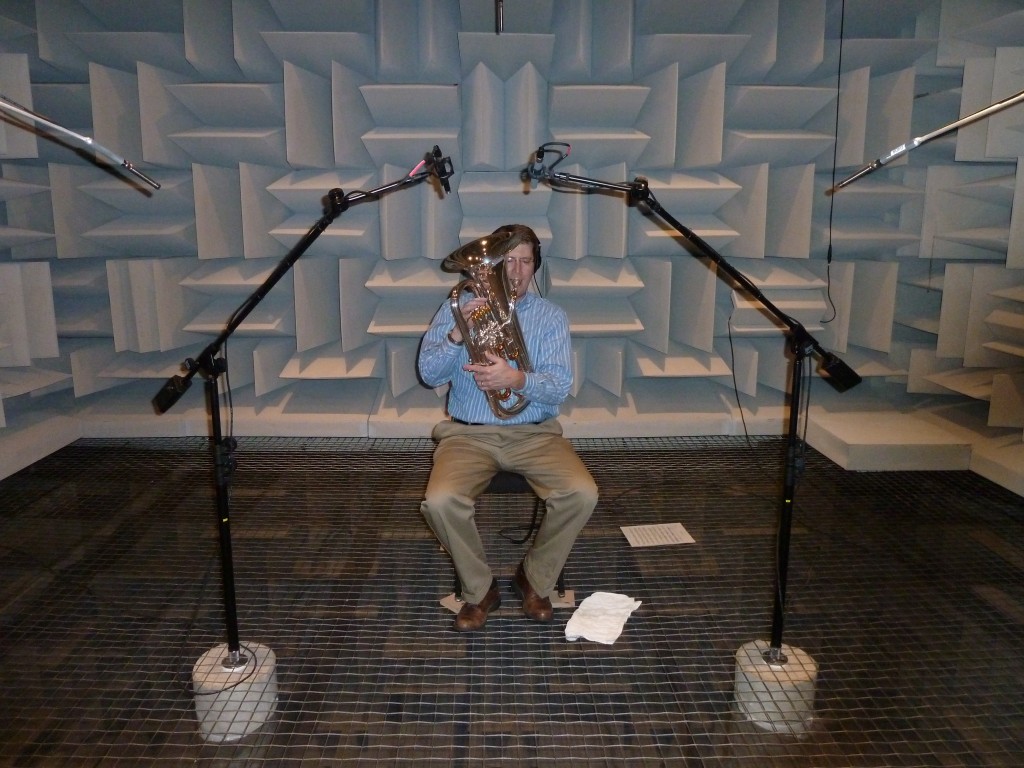 Over the past several weeks I’ve been assisting a colleague, Dr. Timothy Leishman, BYU Professor of Acoustics, to complete a series of anechoic chamber recordings. The recordings are for a grant from the Institute for Scientific Research in Music and will be used in the study of the acoustic properties of musical instruments.
Over the past several weeks I’ve been assisting a colleague, Dr. Timothy Leishman, BYU Professor of Acoustics, to complete a series of anechoic chamber recordings. The recordings are for a grant from the Institute for Scientific Research in Music and will be used in the study of the acoustic properties of musical instruments.
My role has been to record on several of the low brass instruments (tenor trombone, alto trombone, and euphonium), schedule recording sessions for all of the instruments, and serve as musical consultant/liason during recording sessions.
An anechoic chamber, by the way, is a room with special walls, ceiling, and floor designed in such a manner that there are no echoes or reverberation, where reflections that normally affect frequency response can be avoided. Especially noticable in the photos are the wedge-shaped panels covering all surfaces in order to dissipate as much audio energy as possible. The floor is a web of metal cables suspended above a set of acoustic wedges.
 The resulting performing environment for a musician is unusual and challenging. Playing in a “dead” practice room is difficult enough! With no reverb at all, aural feedback becomes noticeably limited. In fact, aural feedback for trombonists, I came to realize, is somewhat unusual among musical instruments. When we play trombone, the majority of the sound radiates in a very directional way out of the bell (which is itself relatively far away from our ears), directly away from us, such that the sound we actually hear and adjust to when we are playing is primarily sound that has reflected off of some surface and then returned to our ears. So when there is nothing for the sound to bounce off of, as in an anechoic chamber, it is challenging to hear what you are doing! Everything sounds softer, of course. The tendency is to play louder and louder in order to hear yourself and try to “create” some kind or resonance. Dynamic shadings (part of what they measured in the study) are difficult because of the lack of aural feedback, and you end up going as much by the feel of your embouchure as by sound.
The resulting performing environment for a musician is unusual and challenging. Playing in a “dead” practice room is difficult enough! With no reverb at all, aural feedback becomes noticeably limited. In fact, aural feedback for trombonists, I came to realize, is somewhat unusual among musical instruments. When we play trombone, the majority of the sound radiates in a very directional way out of the bell (which is itself relatively far away from our ears), directly away from us, such that the sound we actually hear and adjust to when we are playing is primarily sound that has reflected off of some surface and then returned to our ears. So when there is nothing for the sound to bounce off of, as in an anechoic chamber, it is challenging to hear what you are doing! Everything sounds softer, of course. The tendency is to play louder and louder in order to hear yourself and try to “create” some kind or resonance. Dynamic shadings (part of what they measured in the study) are difficult because of the lack of aural feedback, and you end up going as much by the feel of your embouchure as by sound.
 Overall, it’s been a very interesting, educational experience! I plan to take my whole BYU trombone studio on a little field trip to the chamber in the fall. Also planned for the fall is a continued collaboration with Tim Leishman in studying the directivity of each musical instrument–measuring the precise way sound radiates away from each instrument across its full pitch range, then creating 3-dimensional animated models of that “sound bubble” for each instrument.
Overall, it’s been a very interesting, educational experience! I plan to take my whole BYU trombone studio on a little field trip to the chamber in the fall. Also planned for the fall is a continued collaboration with Tim Leishman in studying the directivity of each musical instrument–measuring the precise way sound radiates away from each instrument across its full pitch range, then creating 3-dimensional animated models of that “sound bubble” for each instrument.
Jacob
This is a really neat project. Makes me wish I was back in the studio for the fall.
wkimball
Jacob, I know you’re out of state, but alumni are always welcome, including joining us for the “field trip!” We could have used your legal expertise, by the way—there was a pretty interesting discussion with this acoustics professor (Tim Leishman) and Rusty about legal liability and musicians’ job-induced hearing loss.
Danielle
Wow, that does sound interesting, albeit somewhat torturous! I’m interested to hear what the research produces. Does this mean that trombonists can be notorious for being out of tune more so due to acoustics than the slide or our own inability?
wkimball
I think it could serve as an excuse for all manner of shortcomings! I should add that, after playing in the anechoic chamber, playing almost anywhere else feels like heaven!